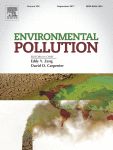Risch et al., 2017
Atmospheric mercury deposition to forests in the eastern USA
Risch, Martin R., DeWild, John F., Gay, David A., Zhang, Leiming, Boyer, Elizabeth W., and Krabbenhoft, David P. (2017)
Environmental Pollution 228(8-18)
-
Boulder, Christina, Luquillo, Shale Hills, Sierra, INVESTIGATOR
Abstract
Atmospheric mercury (Hg) deposition to forests is important because half of the land cover in the eastern USA is forest. Mercury was measured in autumn litterfall and weekly precipitation samples at a total of 27 National Atmospheric Deposition Program (NADP) monitoring sites in deciduous and mixed deciduous-coniferous forests in 16 states in the eastern USA during 2007–2014. These simultaneous, uniform, repeated, annual measurements of forest Hg include the broadest area and longest time frame to date. The autumn litterfall-Hg concentrations and litterfall mass at the study sites each year were combined with annual precipitation-Hg data. Rates of litterfall-Hg deposition were higher than or equal to precipitation-Hg deposition rates in 70% of the annual data, which indicates a substantial contribution from litterfall to total atmospheric-Hg deposition. Annual litterfall-Hg deposition in this study had a median of 11.7 μg per square meter per year (μg/m2/yr) and ranged from 2.2 to 23.4 μg/m2/yr. It closely matched modeled dry-Hg deposition, based on land cover at selected NADP Hg-monitoring sites. Mean annual atmospheric-Hg deposition at forest study sites exhibited a spatial pattern partly explained by statistical differences among five forest-cover types and related to the mapped density of Hg emissions. Forest canopies apparently recorded changes in atmospheric-Hg concentrations over time because litterfall-Hg concentrations decreased year to year and litterfall-Hg concentrations were significantly higher in 2007–2009 than in 2012–2014. These findings reinforce reported decreases in Hg emissions and atmospheric elemental-Hg concentrations during this same time period. Methylmercury (MeHg) was detected in all litterfall samples at all sites, compared with MeHg detections in less than half the precipitation samples at selected sites during the study. These results indicate MeHg in litterfall is a pathway into the terrestrial food web where it can accumulate in the prey of songbirds, bats, and raptors.
Citation
Risch, Martin R., DeWild, John F., Gay, David A., Zhang, Leiming, Boyer, Elizabeth W., and Krabbenhoft, David P. (2017): Atmospheric mercury deposition to forests in the eastern USA. Environmental Pollution 228(8-18). DOI: 10.1016/j.envpol.2017.05.004
Explore Further


